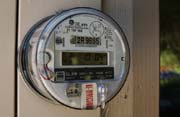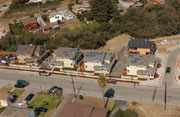
On April 20, 2001, the day after the new law went into effect, we submitted our application for interconnection to PG&E. Perhaps at the time we were a little naive in thinking that PG&E would just accept our application. PG&E has always had a policy of discouraging renewable energy, and we shouldn't have expected our case to be any different.
On May 7, 2001, we received the following email from PG&E:
From: "Green, Richard"
To: "'Adelman@Adelman.COM'" <Adelman@Adelman.COM>
Subject: RE: E-NET Application
Date: Mon, 7 May 2001 18:22:43 -0700
Mr. Adelman:
We have received your application for a 35.7 kW solar system you will be
installing in Corralitos , CA. In response to the expansion of the E-NET
program via AB29X, Pacific Gas and Electric Company is in the process of
revising its E-NET tariffs and interconnection agreements to take into
account the new classes of customers now eligible for net metering. Like
any proposed tariff change, these revisions will need to be reviewed and
approved by the California Public Utilities Commission. Once we have CPUC
approved agreements and rules in place we will forward those new agreements
to you.
Please note that larger generation systems may require modifications to
PG&E's existing facilities. The costs for these modifications, or "special
facilities" will be charged to the party requesting the interconnection. You
should wait for us to review the installation with our engineering staff
before initiating construction of your solar unit.
We will contact you with the results of our review.
Dick Green
gen@pge.com
And on May 24th, 2001, PG&E again responded to our E-NET application:
From: "Green, Richard"
To: "'Adelman@Adelman.COM'" <Adelman@Adelman.COM>
Cc: "'Dlehmicke@aol.com'"
Subject: RE: E-NET Application
Date: Thu, 24 May 2001 11:01:30 -0700
Mr. Adelman:
Fax: 415.973.7891.
Our engineer has reviewed both applications for net metering and concludes:
1) The location of your home on PG&E's distribution system in the Corralitos
area is a limiting factor. Our engineer notes that your first application
for 9.3 kW can move forward without further upgrade costs.
2)The most recent 31 kW application: Would require further study of the 31
kW systems impact on PG&E's system in the Corralitos area which will require
a fee to complete study and determine costs to accommodate load. Engineer
notes that this study will likely find sustantial additional costs for
accepting loads greater than 11 kW, costs you would pay (e.g., installing
new transformer, additional metering, distribution line work). The rules
being developed for these larger than 10 kW systems are in process at the
California Public Utilities Commission.
You mentioned that the solar output into PG&E's system can be controlled by
your system(e.g., at 10kW) while providing all house load / EV vehicle needs
- that may be the least cost option. We need to know how the existing system
controls would limit output and we may install equipment at your expense to
limit loads delivered into PG&E's system.
dick green
415.973.2213
At this point we were in a stand-off with PG&E. In violation of the
new law, they wanted us to pay for an engineering study and they were
refusing to interconnect us until we did. They were relying on
the California Public Utilities Commission
Rule 21,
the regulation that governs electrical generator interconnections.
To date, Rule 21 has not been updated to comply with the new law.
Through the help of the author of the new law, our then-State Assemblyman, Fred Keeley, we reached an agreement with PG&E that they would perform the various studies, and we would agree to pay for them if, when updated to comply with the new law, Rule 21 attributes these charges to us.
Again, being very naive, I assumed that PG&E would now act in good faith and my system will soon be interconnected. A month goes by, and I still haven't heard from Dick Green, so I try to call him. Turns out that he no longer works in the interconnection department. On July 11th, 2001, I'm able to reach Frank Salguero who knows exactly who I am when I mention my name. He informed me that they did perform some of the interconnection study, but that they stopped analyzing when they got to the 20kW level, because, after taxes, it would take $605,000 in upgrades to their local distribution systems, including upgrades to over five miles of distribution line for me to interconnect just two-thirds of my system. He actually had the nerve to tell me that they didn't feel any further study was necessary because they knew that the $605,000 figure would be enough that I wouldn't interconnect my system.
I asked Frank Salguero to put this $605,000 figure in writing and instead received this letter in which he took a big turn. Rather than acknowledging the $605,000 figure that he had previously discussed with me on the phone, PG&E was now taking the position that they had never done the study and that I had to deposit a $7250 fee with them before they would perform it!
Nevertheless, Frank gave me something I needed -- a price that would cause public outrage. Pacific Gas & Electric was bankrupt from having to pay outrageous wholesale prices for peak-time power, and here I was willing to give them peak-time power in exchange for kilowatts that they would deliver to me at 2am to charge my cars. They were acting not just against the best interest of the public, but seemingly against their own best interest!
I went public with the story, first with the San Jose Mercury News, and later with the Santa Cruz Sentinel. This apparently put quite a bit of pressure on PG&E, and I was quite surprised with the result...
On August 2nd, 2001, I receive an unexpected phone call from a local PG&E representative, John Baran. John said that he was instructed to perform the pre-operation safety inspection called for in Rule 21 on my system and asked if he could come out later in the day. Wow. I never expected PG&E to capitulate so quickly. John arrives and gives me a quick pre-inspection talk. He has a checklist with approximately thirty items on it that he needs to check. He says that if I pass all of them, I'm approved for operation. He compliments me that this is the first inspection he has been to where the meter was not already turning backwards when he arrived. He mentions that he had read about my dispute in the San Jose Mercury News and that he was instructed to be firm, but fair. He was both. Two hours later, after completing the inspection and replacing my electric meter, he approved the operation up to the full 30.5kW that the system could produce. At 3pm in the afternoon, he and I observed the system exporting 18kW of power!

Apparently PG&E had a change of heart, although they never even got their story straight. They told Chuck Carroll of the San Jose Mercury News that they had approved operation of the system up to the 10kW level called for in the old law, but they told me that no operation of the system was approved. The first sign that something was wrong was this very humorous message appearing on my answering machine:
I refused to disconnect my system as they requested, as PG&E had no legal grounds with which to revoke a safety inspection already performed. Not surprisingly, their attorneys followed up with these two letters:
Warning letter of August 4th
Disconnection letter of August 7th
The San Jose Mercury doesn't have the stories online anymore, but many of them are available through the Sentinel:
Solar grid turns on despite PG&E dispute
Solar-power squabble drags on
PG&E shuts down solar power system
Assemblyman sides with solar-power system owner
PG&E, homeowner reach agreement on solar-energy system
Quicktime video of KION spot (low resolution, 3.2MB) (high resolution, 12MB)
With this disconnect they again changed their position -- previously they had argued against my connecting to the grid because something might be unsafe with their facilities and a study and upgrades would be required at great expense to me. Now they had to change their story because Rule 21 only permits them to disconnect a power generator if something is unsafe with the generator's facilities.
Instead we learned the true meaning of a Kangaroo Court. The Administrative Law Judge assigned to our case, Judge Walker, refused to give us a hearing on our request for an immediate order, and instead set a date nearly a month away. When the date came, he indicated that he expected us to settle with PG&E, and refused to hear the case on its merits. We introduced evidence that our facilities met all applicable building and electrical codes and that they were safe; PG&E had a witness that testified that he didn't know if anything was unsafe with our facilities because they hadn't studied them. Disregarding all normal rules of evidence, the Judge decided that if PG&E wasn't sure if my facilities were safe, he wasn't going to order them reconnected.
This settlement effectively separated the issue specific to my situation -- the disconnected service, from the issue affecting all customers at large -- the fees and charges that PG&E wants to pass onto net-metered customers. It permits us to litigate the issues over these charges with the power restored to our home. We will not "settle" or reach a partial agreement with PG&E over these charges. It is important to all Californians that PG&E be required to comply with the law.
PG&E now agrees that we can interconnect at a 20kW level without creating a safety hazard, but they further delayed us operating at the 20kW level by asking for the Public Utilities Commission's approval. This took over a month, but on October 17, 2001, we received authorization to increase the output of our system to 20kW. Note that no modifications or changes to either PG&E's or our system were required to feed 20kW safely. A far cry from the $605,000 figure they originally quoted.
We have filed a brief in the Rule 21 rulemaking docket outlining our belief that the law means what it says. The investor-owned utilities in California, including PG&E, are taking the position that the California Public Utilities Code Section 2827 does not prevent them from discouraging renewable energy by charging outrageous and unjustified interconnection fees.
What part of "Any new or additional demand charge, standby charge, customer charge, minimum monthly charge, interconnection charge, or other charge that would increase an eligible customer-generator's costs beyond [...] are contrary to the intent of this legislation, and shall not form a part of net energy metering contracts or tariffs." don't they understand?
Next we all need to work in Sacramento to reform the laws that permit PG&E to fight people who want to spend their own money building renewable energy resources. We need to reform the laws that permit PG&E to spend ratepayer money fighting for the interests of their shareholders.
The ruling is, however, a major victory for our system. The interconnection costs have now dropped from $605,000 to approximately $11,000.
This is almost exactly what we expected to pay when we designed the system in the first place, albeit for a different reason. Our home used to share a 10kVA transformer with a neighbor -- we expected PG&E to want to upgrade this at our expense because it would have been overloaded by our solar system. That transformer was also overloaded by our electric car charging, and was subsequently replaced with a 25kVA. We were asked to pay for a new transformer as part of this settlement, not because it was overloaded, but because we shared it with one neighbor. An obscure CPUC regulation limits customer generation on a shared transformer to 20kW.
Had PG&E respected the law in the first place, we would have written them a check a year ago and never had a dispute with them! Why did they fight us? Because they could do so at ratepayer expense -- whether they win or lose, the Public Utilities Commission will award them a rate increase to cover their legal fees!


A beautiful sight. All new homes should include solar energy.
PG&E is harrassing the developer of this subdivision and these homeowners by delaying their interconnection until they can perform a study on the suitability of the inverters being used. These are Trace Engineering UL1741-certified inverters; the law is quite clear that PG&E is not permitted to require additional testing. Their theory is that, in aggregate, these systems total more than 10kW (the maximum a single customer could have under the old law), and that therefore they should be treated as a single, larger, customer, and denied interconnection until the California Public Utilities Commission updates Rule 21.